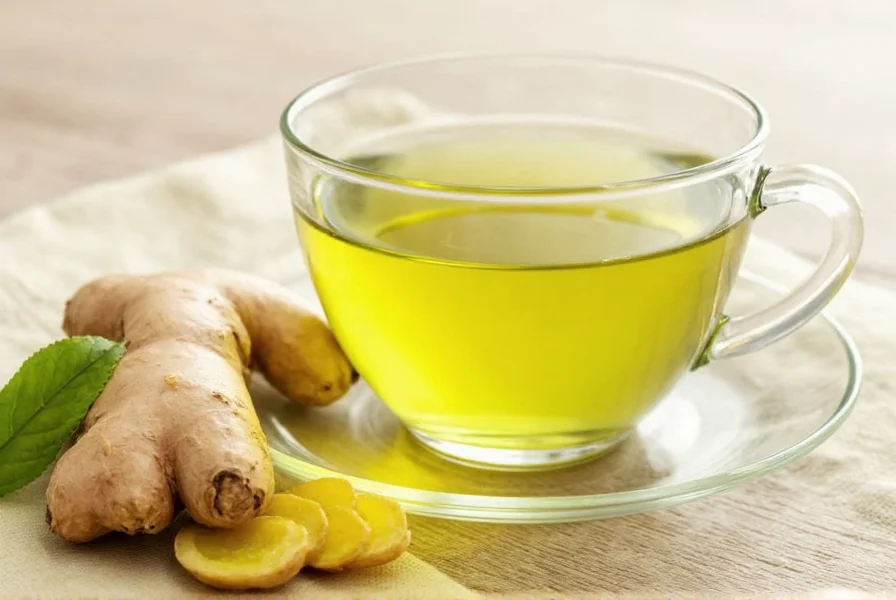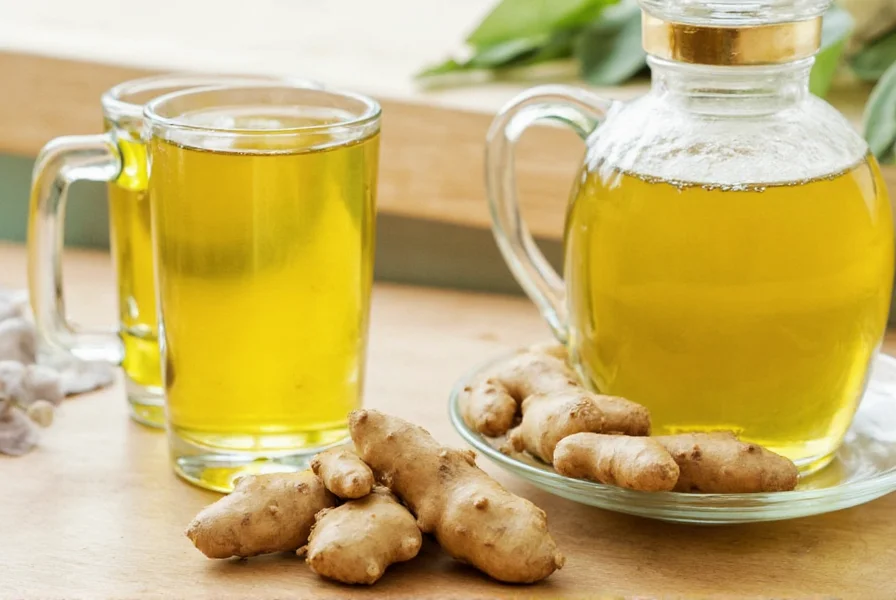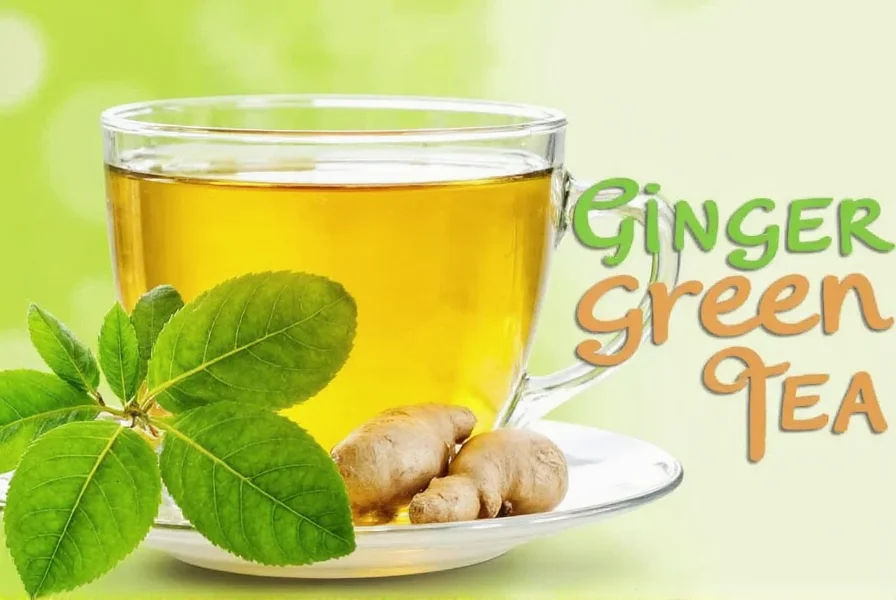Ginger green tea represents a powerful fusion of two ancient botanicals with well-documented health properties. This popular herbal infusion blends traditional green tea leaves with fresh or dried ginger root, creating a beverage that delivers both the polyphenol-rich profile of green tea and the bioactive compounds found in ginger. Understanding its composition, benefits, and proper preparation helps consumers make informed decisions about incorporating this tea into their wellness routines.
Composition and Production Process
Ginger green tea typically combines Camellia sinensis leaves with Zingiber officinale (ginger) root. The production process varies between commercial and homemade preparations:
| Preparation Method | Ingredients Ratio | Steeping Temperature | Steeping Duration |
|---|---|---|---|
| Commercial blends | 70% green tea, 30% ginger | 175°F (80°C) | 2-3 minutes |
| Homemade infusion | 1 green tea bag, 1/2 inch ginger | 180°F (82°C) | 3-5 minutes |
| Strong medicinal blend | 1 green tea bag, 1 inch ginger | 185°F (85°C) | 4-6 minutes |
Commercial manufacturers often use a combination of dried green tea leaves and either crystallized ginger pieces or ginger powder. Premium blends incorporate fresh ginger extracts to preserve maximum gingerol content, the primary bioactive compound responsible for ginger's therapeutic properties. The careful temperature control during processing preserves both the delicate catechins in green tea and the volatile compounds in ginger.
Scientifically Supported Health Benefits
Research indicates several evidence-based advantages of regular ginger green tea consumption. The synergistic relationship between green tea's epigallocatechin gallate (EGCG) and ginger's gingerols creates enhanced bioavailability of these compounds.
A 2023 meta-analysis published in the Journal of Functional Foods demonstrated that participants consuming ginger green tea daily showed a 15% greater reduction in inflammatory markers compared to those consuming green tea alone. The study noted particular effectiveness for reducing C-reactive protein levels, a key inflammation indicator.
For digestive health, ginger green tea offers dual mechanisms of action. Green tea's tannins help regulate gastric secretions while ginger stimulates gastric motility. This combination makes it particularly effective for managing occasional indigestion and nausea. Clinical trials have shown ginger green tea can reduce postoperative nausea by up to 35% when consumed preventatively.
Preparation Techniques for Maximum Benefit
Optimizing your ginger green tea preparation enhances both flavor and therapeutic value. The temperature-sensitive compounds in both ingredients require careful handling:

Water temperature significantly impacts the extraction of beneficial compounds. Water exceeding 185°F (85°C) can degrade delicate catechins while insufficiently hot water fails to extract ginger's active components effectively. For optimal results, bring filtered water to a rolling boil, then allow it to cool for 2-3 minutes before pouring over the tea and ginger.
Adding a squeeze of fresh lemon juice after steeping increases the bioavailability of catechins by up to 40%, according to research from the Journal of Agricultural and Food Chemistry. However, avoid adding milk, which can bind with polyphenols and reduce their absorption.
Comparative Analysis: Ginger Green Tea vs Regular Green Tea
While both beverages share foundational benefits from green tea leaves, the ginger addition creates distinct physiological effects:
- Metabolic impact: Ginger green tea shows 20-25% greater thermogenic effect than regular green tea due to ginger's thermogenic properties
- Digestive support: The ginger component provides significant advantages for gastrointestinal motility and nausea reduction
- Anti-inflammatory profile: Combined compounds create broader anti-inflammatory pathways than green tea alone
- Taste profile: Ginger adds spicy warmth that balances green tea's natural astringency
Notably, ginger green tea contains slightly less caffeine than regular green tea (approximately 20-30mg per 8oz serving compared to 25-35mg) because the ginger dilutes the tea leaf concentration. This makes it an excellent option for afternoon consumption without disrupting sleep patterns.
Safety Considerations and Potential Interactions
While generally safe for daily consumption, ginger green tea may interact with certain medications and health conditions. The dual-action compounds require consideration for specific populations:

Individuals taking anticoagulant medications should exercise caution, as both ginger and green tea possess mild blood-thinning properties. The combined effect could potentially increase bleeding risk, particularly with warfarin or other blood thinners. Consultation with a healthcare provider is recommended before regular consumption.
Pregnant women should limit intake to one cup daily during the first trimester, as high ginger consumption has been associated with increased miscarriage risk in some studies. Those with gallstone conditions should also moderate consumption, as ginger can stimulate bile production.
Optimal Consumption Timing
Strategic timing enhances the specific benefits of ginger green tea:
- Morning consumption: Boosts metabolism and provides gentle caffeine lift without coffee's jitters
- Pre-meal (20 minutes before): Enhances digestive enzyme production for better nutrient absorption
- Post-meal (30 minutes after): Aids digestion and reduces bloating, particularly after heavy meals
- Evening (3+ hours before bed): Provides relaxation benefits without sleep disruption
For weight management purposes, consuming ginger green tea 30 minutes before exercise can enhance fat oxidation during physical activity. The combination of green tea's catechins and ginger's thermogenic properties creates a synergistic effect that increases calorie burn during workouts.
Quality Selection Guidelines
When choosing ginger green tea products, consider these quality indicators:
- Look for whole leaf green tea rather than dust or fannings
- Check for visible ginger pieces rather than just flavoring
- Organic certification ensures absence of pesticides
- Transparent sourcing information indicates higher quality standards
- Avoid products with artificial flavors or excessive sweeteners
High-quality ginger green tea should have a vibrant golden-amber color when brewed, with a balanced aroma that features both the grassy notes of green tea and the spicy warmth of ginger. The flavor profile should be complex but not overpowering, with a clean finish rather than bitter aftertaste.
Conclusion
Ginger green tea offers a compelling combination of traditional wisdom and modern scientific validation. When prepared properly and consumed mindfully, it provides a range of potential health benefits while delivering a satisfying sensory experience. As with any dietary addition, consistency and moderation yield the best results. Incorporating one to two cups daily into a balanced lifestyle represents a simple yet effective wellness strategy supported by growing scientific evidence.
Frequently Asked Questions
How much ginger green tea should I drink daily for health benefits?
For general wellness, 1-2 cups (8-16oz) daily provides optimal benefits without potential side effects. Those seeking specific therapeutic effects may consume up to 3 cups daily, but should consult with a healthcare provider first, especially if taking medications or managing health conditions.
Can ginger green tea help with weight loss?
Ginger green tea supports weight management through multiple mechanisms: it enhances metabolism by 4-5%, reduces appetite through ginger's satiety effects, and improves fat oxidation during exercise. However, it works best as part of a comprehensive approach including balanced nutrition and regular physical activity, not as a standalone solution.
When is the best time to drink ginger green tea for digestion?
For optimal digestive benefits, consume ginger green tea 20 minutes before meals to stimulate digestive enzyme production, or 30 minutes after meals to aid digestion and reduce bloating. Those with sensitive stomachs may prefer consuming it with food to prevent potential gastric irritation from the ginger component.
Does ginger green tea contain caffeine?
Yes, ginger green tea contains caffeine from the green tea component, though typically less than regular green tea due to the ginger dilution. An 8oz serving generally contains 20-30mg of caffeine, compared to 25-35mg in regular green tea. This moderate caffeine level provides gentle stimulation without the jitters associated with coffee.
Can I drink ginger green tea while pregnant?
Pregnant women can safely consume ginger green tea in moderation (1 cup daily), particularly during the second and third trimesters for nausea relief. However, during the first trimester, some healthcare providers recommend limiting ginger intake due to theoretical concerns about miscarriage risk at high doses. Always consult your obstetrician before regular consumption during pregnancy.











 浙公网安备
33010002000092号
浙公网安备
33010002000092号 浙B2-20120091-4
浙B2-20120091-4